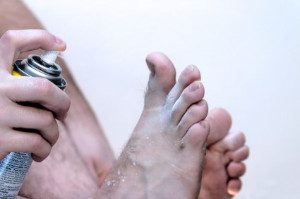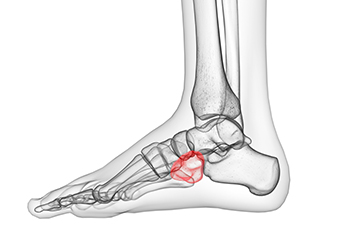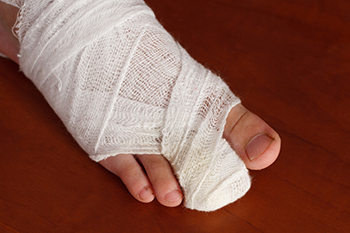September 2023
Causes and Prevention of Athlete’s Foot

Athlete's foot, a common fungal infection of the skin on the feet, can cause discomfort and itching, making it essential to understand its causes and preventive measures. This contagious infection thrives in warm, moist environments, making sweaty feet or damp socks and shoes prime breeding grounds. Walking barefoot in public places such as locker rooms, swimming pool areas, or communal showers increases the risk of exposure to the fungus. Sharing towels, shoes, or socks with an infected person can also facilitate its spread. Certain factors can make individuals more susceptible to athlete's foot, such as compromised immune systems, diabetes, or excessive sweating. To prevent this bothersome condition, it is helpful to maintain good foot hygiene by washing and drying your feet thoroughly, especially between the toes. Keep feet dry and avoid tight, non-breathable shoes. If you suspect you have athlete's foot, it is suggested that you consult a podiatrist for prompt treatment to prevent further complications and the spread of the infection.
Athlete’s Foot
Athlete’s foot is often an uncomfortable condition to experience. Thankfully, podiatrists specialize in treating athlete’s foot and offer the best treatment options. If you have any questions about athlete’s foot, consult with Eveleigh Williams, DPM from Sole 2 Sole, PC. Our doctor will assess your condition and provide you with quality treatment.
What Is Athlete’s Foot?
Tinea pedis, more commonly known as athlete’s foot, is a non-serious and common fungal infection of the foot. Athlete’s foot is contagious and can be contracted by touching someone who has it or infected surfaces. The most common places contaminated by it are public showers, locker rooms, and swimming pools. Once contracted, it grows on feet that are left inside moist, dark, and warm shoes and socks.
Prevention
The most effective ways to prevent athlete’s foot include:
- Thoroughly washing and drying feet
- Avoid going barefoot in locker rooms and public showers
- Using shower shoes in public showers
- Wearing socks that allow the feet to breathe
- Changing socks and shoes frequently if you sweat a lot
Symptoms
Athlete’s foot initially occurs as a rash between the toes. However, if left undiagnosed, it can spread to the sides and bottom of the feet, toenails, and if touched by hand, the hands themselves. Symptoms include:
- Redness
- Burning
- Itching
- Scaly and peeling skin
Diagnosis and Treatment
Diagnosis is quick and easy. Skin samples will be taken and either viewed under a microscope or sent to a lab for testing. Sometimes, a podiatrist can diagnose it based on simply looking at it. Once confirmed, treatment options include oral and topical antifungal medications.
If you have any questions, please feel free to contact our office located in Olympia Fields, IL . We offer the newest diagnostic and treatment technologies for all your foot care needs.
Dealing With Lateral Foot Pain

Cuboid syndrome is a frequent cause of lateral foot pain, primarily affecting the outer side of the foot. Athletes like ballet dancers and runners are often affected, with the condition resulting from the partial dislocation of the cuboid bone. This dislocation can occur suddenly due to injuries like ankle sprains or develop gradually from repetitive stress on the bone. Cuboid syndrome is characterized by the cuboid bone acting as a block, restricting the movement of surrounding foot bones. Three primary causes of cuboid syndrome include ankle injuries, repetitive strain, and altered foot biomechanics, often associated with flat feet. Symptoms encompass lateral foot pain, worsened with activity, difficulty walking, tenderness, swelling, and weakness during activities like walking, running, and jumping. Diagnosis is often challenging, and this condition can be misdiagnosed. Imaging studies may not reveal cuboid dislocation, but a physical examination involving palpation and specific tests can help identify the condition. Treatment options involve exercises to improve mobility, strength, and stability, as well as rest. A podiatrist can also manipulate and reposition the cuboid, tape it for support, prescribe orthotics, or recommend cuboid wedges to correct foot positioning. If you have lateral foot pain, it is suggested that you make an appointment with a podiatrist to obtain an accurate diagnosis and treatment that is right for you.
Cuboid syndrome, also known as cuboid subluxation, occurs when the joints and ligaments near the cuboid bone in the foot become torn. If you have cuboid syndrome, consult with Eveleigh Williams, DPM from Sole 2 Sole, PC. Our doctor will assess your condition and provide you with quality foot and ankle treatment.
Cuboid syndrome is a common cause of lateral foot pain, which is pain on the outside of the foot. The condition may happen suddenly due to an ankle sprain, or it may develop slowly overtime from repetitive tension through the bone and surrounding structures.
Causes
The most common causes of cuboid syndrome include:
- Injury – The most common cause of this ailment is an ankle sprain.
- Repetitive Strain – Tension placed through the peroneus longus muscle from repetitive activities such as jumping and running may cause excessive traction on the bone causing it to sublux.
- Altered Foot Biomechanics – Most people suffering from cuboid subluxation have flat feet.
Symptoms
A common symptom of cuboid syndrome is pain along the outside of the foot which can be felt in the ankle and toes. This pain may create walking difficulties and may cause those with the condition to walk with a limp.
Diagnosis
Diagnosis of cuboid syndrome is often difficult, and it is often misdiagnosed. X-rays, MRIs and CT scans often fail to properly show the cuboid subluxation. Although there isn’t a specific test used to diagnose cuboid syndrome, your podiatrist will usually check if pain is felt while pressing firmly on the cuboid bone of your foot.
Treatment
Just as the range of causes varies widely, so do treatments. Some more common treatments are ice therapy, rest, exercise, taping, and orthotics.
If you have any questions, please feel free to contact our office located in Olympia Fields, IL . We offer the newest diagnostic and treatment technologies for all your foot care needs.
Foot Swelling During Pregnancy

Edema, the swelling or puffiness of body parts, can be a common discomfort during pregnancy. It typically affects the feet, ankles, and legs. This condition can also result in discomfort, potentially limiting the range of motion in your ankles. Edema occurs when excess fluid accumulates in the body's tissues. Several factors can contribute to this buildup, including gravity, diet, medication, and certain medical conditions. Fluid is naturally pulled down into your legs and feet, and sitting or standing for prolonged periods, especially in hot weather, can make swelling worse. Excessive amounts of salt can lead to fluid retention. Edema is not contagious, nor does it have a genetic predisposition. Regular exercise, such as walking, can aid in reducing edema by working the calf muscles, which assist in fluid circulation. It is also a good idea to elevate your legs as often as possible and wear some type of compression socks. Edema during pregnancy is a common occurrence, but it can be managed with lifestyle modifications and medical intervention. For more information on edema in the feet and ankles, it is suggested that you make an appointment with a podiatrist.
Pregnant women with swollen feet can be treated with a variety of different methods that are readily available. For more information about other cures for swollen feet during pregnancy, consult with Eveleigh Williams, DPM from Sole 2 Sole, PC. Our doctor will attend to all of your foot and ankle needs.
What Foot Problems Can Arise During Pregnancy?
One problem that can occur is overpronation, which occurs when the arch of the foot flattens and tends to roll inward. This can cause pain and discomfort in your heels while you’re walking or even just standing up, trying to support your baby.
Another problem is edema, or swelling in the extremities. This often affects the feet during pregnancy but tends to occur in the later stages.
How Can I Keep My Feet Healthy During Pregnancy?
- Wearing orthotics can provide extra support for the feet and help distribute weight evenly
- Minimize the amount of time spent walking barefoot
- Wear shoes with good arch support
- Wear shoes that allow for good circulation to the feet
- Elevate feet if you experience swelling
- Massage your feet
- Get regular, light exercise, such as walking, to promote blood circulation to the feet
If you have any questions please feel free to contact our office located in Olympia Fields, IL . We offer the newest diagnostic and treatment technologies for all your foot and ankle needs.
Surgery for the Smaller Toes

Small toe problems can be more than just an inconvenience, they can impact your daily life, cause discomfort, and hinder your ability to move freely. When non-surgical solutions fall short of providing relief, surgery emerges as a viable option to address these issues effectively. Deformities like claw toe and hammer toe are common causes of small toe discomfort. Small toe surgery focuses on correcting these deformities and alleviating associated pain. The procedures can involve releasing or lengthening tendons, repositioning joints, removing excess bone, stiffening joints, or realigning bones. Preparing for surgery is essential to ensure a smooth and successful outcome. Quitting smoking, maintaining a healthy weight, and engaging in regular exercise can also contribute to a smoother recovery. Potential risks involved in small toe surgery include infection, bleeding, nerve or blood vessel damage, bone healing issues, and loss of toe movement. Full recovery, including reduced swelling and optimal functionality, may take up to six months. If you're considering toe surgery, it is suggested that you consult with a podiatrist to discuss your options.
A broken toe can be very painful and lead to complications if not properly fixed. If you have any concerns about your feet, contact Eveleigh Williams, DPM from Sole 2 Sole, PC. Our doctor will treat your foot and ankle needs.
What to Know About a Broken Toe
Although most people try to avoid foot trauma such as banging, stubbing, or dropping heavy objects on their feet, the unfortunate fact is that it is a common occurrence. Given the fact that toes are positioned in front of the feet, they typically sustain the brunt of such trauma. When trauma occurs to a toe, the result can be a painful break (fracture).
Symptoms of a Broken Toe
- Throbbing pain
- Swelling
- Bruising on the skin and toenail
- The inability to move the toe
- Toe appears crooked or disfigured
- Tingling or numbness in the toe
Generally, it is best to stay off of the injured toe with the affected foot elevated.
Severe toe fractures may be treated with a splint, cast, and in some cases, minor surgery. Due to its position and the pressure it endures with daily activity, future complications can occur if the big toe is not properly treated.
If you have any questions please feel free to contact our office located in Olympia Fields, IL . We offer the newest diagnostic and treatment technologies for all your foot and ankle needs.









